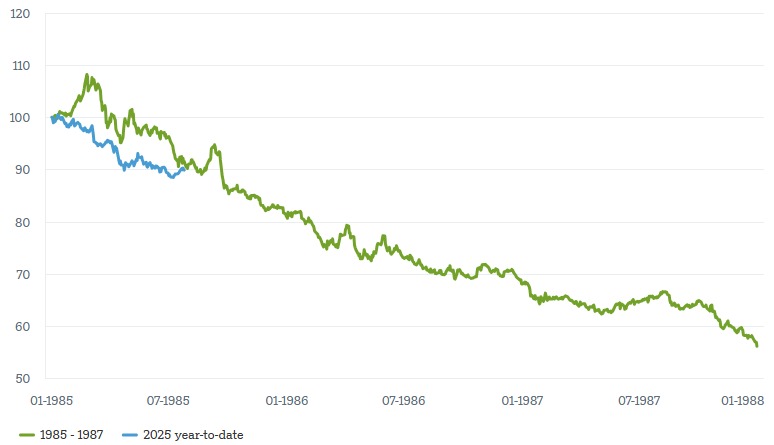El 90% de las transacciones de divisas se realizan en dólares estadounidenses, con aproximadamente 7,5 billones de USD negociados diariamente en los mercados de divisas[1]. Internacionalmente, el 58% de las reservas se mantienen en dólares[2]. El dólar estadounidense sigue siendo la moneda global más importante. Sin embargo, actualmente atraviesa una fase de debilidad, que recuerda al período del Acuerdo de Plaza en la década de 1980.
En 1985, el dólar se había apreciado un 44% frente a una cesta de las principales divisas durante cinco años, impulsado por una combinación de política monetaria estricta en EE.UU. y política fiscal expansiva [3]. Este aumento del valor del dólar ejerció una presión creciente sobre la industria manufacturera estadounidense al encarecer las exportaciones y abaratar relativamente las importaciones, y contribuyó a un creciente déficit presupuestario, que alcanzó los 112.000 millones de USD en 1984.
En respuesta, el Acuerdo de Plaza fue implementado en 1985 por las naciones del G5 –Francia, Alemania, Reino Unido, Estados Unidos y Japón– con el objetivo colectivo de debilitar el dólar estadounidense y estimular la demanda interna en Japón y Alemania. La estrategia resultó eficaz: para 1987, el dólar había caído un 40%, mientras que el marco alemán y el yen se habían apreciado significativamente. Para 1991, el déficit presupuestario estadounidense había descendido a 30.000 millones de USD.
Paralelismos entre el dólar estadounidense ahora y al inicio del Acuerdo de Plaza
Índice del dólar estadounidense (DXY), indexado: 1/1/85 y 1/1/25 respectivamente = 100

El índice del dólar estadounidense (DXY) mide el valor del dólar frente a una cesta de seis divisas extranjeras: el euro, el yen japonés, la libra esterlina, el dólar canadiense, la corona sueca y el franco suizo. Antes de la creación del euro, el índice contenía diez divisas —las que se incluyen actualmente (excepto el euro), más el marco alemán, el franco francés, la lira italiana, el florín neerlandés y el franco belga—. El euro reemplazó a estas últimas cinco. Fuentes: Bloomberg Finance L.P., DWS Investment GmbH, al 21/07/2025.
Nuestro gráfico destaca que la marcada caída del dólar en lo que va de 2025 sigue un camino similar al descenso del dólar en la fase inicial del “Acuerdo de Plaza” de 1985 [4]. Existen paralelismos con el pasado que sugieren una depreciación continua del dólar en los próximos años. El presidente actual de EE.UU. está enfocado en fortalecer el sector manufacturero y reducir el déficit comercial. Al mismo tiempo, la incertidumbre política en EE.UU. está aumentando, y los bancos centrales están reduciendo gradualmente sus tenencias en dólares en favor del oro, el euro o el renminbi chino. Mientras tanto, los países europeos están estimulando activamente sus propias economías.
No obstante, la tendencia bajista del dólar podría no ser tan intensa o rápida como en 1985, principalmente porque no existen acuerdos transfronterizos coordinados para debilitar la moneda. En cambio, el cambio en el valor del dólar parece estar impulsado por la variación del sentimiento de los inversores, con crecientes dudas sobre EE.UU. como refugio seguro[5], lo que impulsa la reasignación de capital.
Estamos monitoreando de cerca el movimiento del dólar, pero actualmente no vemos grandes riesgos de una devaluación masiva y rápida. El dólar sigue siendo la moneda global indiscutida debido a su alta liquidez, su condición de divisa más negociada del mundo, el tamaño de la economía estadounidense y la profundidad y eficiencia de sus mercados financieros. En la actualidad, no existe una alternativa única y realista capaz de reemplazarlo. Nuestras previsiones a más largo plazo asumen un debilitamiento continuo de la moneda estadounidense, pero no una devaluación dramática comparable al “Acuerdo de Plaza”.[6]
Tribuna de Xueming Song, estratega de divisas en DWS
Referencias
See “Global FX trading hits record $7.5 trln a day – BIS survey,” Reuters; as of October 2022
See “U.S. Dollar Defends Role as Global Currency,” Statista; as of January 2025
See “The Plaza Accord 30 Years Later,” scholar.harvard.edu; as of December 2015
Bloomberg Finance L.P.; as of July 21, 2025
Financial safe havens are investments or assets that are expected to retain or increase in value during times of market turbulence.
For a more detailed assessment, read our CIO Special, “First cracks in the dollar’s dominance,” as of 7/16/25.
This information is subject to change at any time, based upon economic, market and other considerations and should not be construed as a recommendation. Past performance is not indicative of future returns. Forecasts are based on assumptions, estimates, opinions and hypothetical models that may prove to be incorrect. Alternative investments may be speculative and involve significant risks including illiquidity, heightened potential for loss and lack of transparency. Alternatives are not suitable for all clients. Source: DWS Investment GmbH.
DWS and FundsSociety are not affiliated.
This information is subject to change at any time, based upon economic, market and other considerations and should not be construed as a recommendation. Past performance is not indicative of future returns. Forecasts are not a reliable indicator of future performance. Forecasts are based on assumptions, estimates, opinions and hypothetical models that may prove to be incorrect. Alternative investments may be speculative and involve significant risks including illiquidity, heightened potential for loss and lack of transparency. Alternatives are not suitable for all clients. Source: DWS Investment GmbH.
Important information – EMEA, APAC & LATAM
DWS is the brand name of DWS Group GmbH & Co. KGaA and its subsidiaries under which they do business. The DWS legal entities offering products or services are specified in the relevant documentation. DWS, through DWS Group GmbH & Co. KGaA, its affiliated companies and its officers and employees (collectively “DWS”) are communicating this document in good faith and on the following basis.
This document is for information/discussion purposes only and does not constitute an offer, recommendation or solicitation to conclude a transaction and should not be treated as investment advice.
This document is intended to be a marketing communication, not a financial analysis. Accordingly, it may not comply with legal obligations requiring the impartiality of financial analysis or prohibiting trading prior to the publication of a financial analysis.
This document contains forward looking statements. Forward looking statements include, but are not limited to assumptions, estimates, projections, opinions, models and hypothetical performance analysis. No representation or warranty is made by DWS as to the reasonableness or completeness of such forward looking statements. Past performance is no guarantee of future results.
The information contained in this document is obtained from sources believed to be reliable. DWS does not guarantee the accuracy, completeness or fairness of such information. All third party data is copyrighted by and proprietary to the provider. DWS has no obligation to update, modify or amend this document or to otherwise notify the recipient in the event that any matter stated herein, or any opinion, projection, forecast or estimate set forth herein, changes or subsequently becomes inaccurate.
Investments are subject to various risks. Detailed information on risks is contained in the relevant offering documents.
No liability for any error or omission is accepted by DWS. Opinions and estimates may be changed without notice and involve a number of assumptions which may not prove valid.
DWS does not give taxation or legal advice.
This document may not be reproduced or circulated without DWS’s written authority.
This document is not directed to, or intended for distribution to or use by, any person or entity who is a citizen or resident of or located in any locality, state, country or other jurisdiction, including the United States, where such distribution, publication, availability or use would be contrary to law or regulation or which would subject DWS to any registration or licensing requirement within such jurisdiction not currently met within such jurisdiction. Persons into whose possession this document may come are required to inform themselves of, and to observe, such restrictions.
106928-1 (8/25) (ORIG: RBA0037_082244_207 As of 7/22/25)



